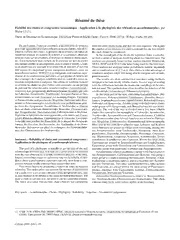
Fiabilité des clades et congruence taxinomique - Application à la phylogénie des téléostéens acanthomorphes PDF
Preview Fiabilité des clades et congruence taxinomique - Application à la phylogénie des téléostéens acanthomorphes
Résumé de thèse Fiabilité des clades et congruence taxinomique - Application à la phylogénie des téléostéens acanthomorphes, par Blaise LI (1). Thèse de Doctorat en Systématique, Université Pierre et Marie Curie - Paris 6, 2008, 217 p., 30 figs, 4 tabs, 86 réfs. En phylogénie, l’analyse combinée d’un ensemble de données with the clade under focus and that are also repeated. The higher peut faire apparaître des clades robustes mais pas fiables. Afin d’es- the number of occurrences of a clade’s contradictor, the less reliable timer la fiabilité des clades, la présente thèse propose un indice de the clade should be considered. répétition prenant en compte le nombre d’occurrences obtenues In the second part of the thesis, the repetition index is calculat- pour un clade sur un ensemble d’analyses de données indépendan- ed from a series of analyses involving about two hundred taxa. The tes. Il est également tenu compte de la présence ou non de clades analyses are primarily based on four nuclear markers: Rhodopsin, eux-mêmes répétés et incompatibles avec le clade d’intérêt. L’indi- MLL4, IRBP and RNF213 (the latter being used for the first time). ce de répétition est appliqué à un ensemble de données d’environ These markers are analysed under probabilistic models, separately 200 taxons et comportant quatre marqueurs nucléaires, dont un and in combinations of 2, 3 or 4. This allows to take advantage of nouvellement utilisé : RNF213. Ces marqueurs sont analysés sépa- combined analyses while still being able to compare sets of inde- rément et en combinaisons partielles, ce qui permet de bénéficier pendent results. des avantages de l’analyse combinée tout en ayant des séries de The results are then summarized into trees using methods résultats indépendants à comparer. Des arbres de synthèse incluant designed to include mostly reliable clades. Several ways of dealing en priorité les clades les plus fiables sont construits, ce qui permet with the differences between the taxonomic samplings of the data- de préciser les relations entre acanthomorphes (Actinopterygii : sets are used. The synthesis trees allow to refine the structure of the Teleostei). Les groupements traditionnellement reconnus que sont acanthomorph (Actinopterygii: Teleostei) phylogeny. les Labroidei, Scombroidei, Trachinoidei, Scorpaeniformes et Gas- In the basal part of the tree, containing Lampridiformes, Per- terosteiformes ne sont clairement pas monophylétiques. Cichlidae copsiformes, Polymixiiformes, Gadiformes, Zeioidei, Beryci- et Pomacentridae sont proches des Mugilidae, Gobiesocoidei, Blen- formes, Stephanoberyciformes, Ophidiiformes, Batrachoidiformes, nioidei et Atherinomorpha. Les Gobioidei sont probablement grou- Gobioidei and Apogonidae, Zeioidei group with Gadiformes; Gobi- pe-frère des Apogonidae. Scombridae et Trichiuridae se placent oidei group with Apogoniade, and Beryciformes are not mono- dans un clade contenant Stromateoidei, Bramidae, Chiasmodonti- phyletic. The rest of the tree is divided into a few main reliable dae, Syngnathoidei, Dactylopteroidei, Callionymoidei et Mullidae. clades that contradict the monophyly of Labroidei, Scombroidei, Xiphiidae et Sphyraenidae sont apparentés, entre autres, aux Caran- Trachinoidei, Scorpaeniformes and Gasterosteiformes. Cichlidae goidei, Pleuronectiformes, Centropomidae et Toxotidae. Les Gaste- and Pomacentridae (two labroid families) are related to Plesiopi- rosteoidei sont proches des Zoarcoidei, de la plupart des Scorpaeni- dae, Mugilidae, Gobiesocoidei, Blennioidei and Atherinomorpha. formes, des Percidae, des Serranidae, des Trachinidae et des Noto- Most taxa in this clade have adhesive eggs. Labridae and Scaridae thenioidei. Indostomus est placé en compagnie des Symbranchifor- (other labroids) are placed in a large clade containing, among oth- mes, des Channoidei et des Anabantoidei. ers, Notothenioidei, most Trachinoidei, Serranidae, most Scor- paeniformes, Zoarcoidei, Gasterosteoidei, Moronidae, Centrarchi- dae, Elassomatidae, Lutjanidae, Sciaenidae, Acanthuroidei, Tetrao- Summary. - Reliability of clades and taxonomical congruence - dontiformes, Lophiiformes and Caproidei. Within this large clade, Application to the phylogeny of acanthomorph teleosts. Caproidei are related to Tetraodontiformes and Lophiiformes; Epigonidae group with Howellidae and Lateolabracidae; Gaster- The goal of a phylogeny is usually to get an idea of the real osteoidei group with Zoarcoidei, Cottoidei and Platycephaloidei. relationships between taxa. It is thus not a good idea to be satisfied Syngnathoidei (Gasterosteiformes) group with Dactylopteroi- with the tree obtained by a simple combined analysis of the data. dei (Scorpaeniformes), Callionymoidei and Mullidae. This group is Indeed, even robust clades in such a tree may not be reliable. Confi- sister-group to a clade containing Stromateoidei, Bramidae, Chias- dence about a phylogenetic statement can only stem from a com- modontidae (a trachinoid family), and two Scombroidei: Scombri- parison between results obtained from independent data. dae and Trichiuridae. Two other scombroid families, Sphyraenidae This thesis begins by proposing a repetition index to measure and Xiphiidae, are placed within the stem-group of Pleuronecti- reliability. This index takes into account the number of occurrences formes, together with Carangoidei, Latidae, Centropomidae, for a clade over a set of trees obtained from independent data, that Polynemidae, Menidae and Toxotidae. is, data unlikely to be subject to the same reconstruction biases. The Indostomus (Gasterosteiformes) is related to Mastacembeloi- more a clade occurs this way, the more it can be considered reliable. dei, Symbranchoidei, Channoidei and Anabantoidei. This clade The index also takes into account clades that are not compatible contains many fresh-water fishes capable of air breathing. Key words. - Acanthomorpha - Clades - Phylogeny - Reliability - Supertree - Taxonomical congruence. (1) UMR 7138, CNRS-IRD-MNHN-UPMC, Muséum national d’Histoire naturelle, Département Systématique et Évolution, 43 rue Cuvier, Case postale 26, 75005 Paris, FRANCE. [[email protected]] Cybium 2009, 33(1): 38.
